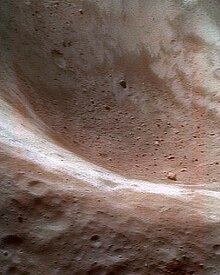
Back برنامج ديسكفري Arabic Programa Discovery Catalan پرۆژەی دیسکۆڤەری CKB Program Discovery Czech Discovery-Programm German Programa Discovery Spanish Discovery programm Estonian برنامه دیسکاوری Persian Programme Discovery French Discovery Irish



The Discovery Program is a series of Solar System exploration missions funded by the U.S. National Aeronautics and Space Administration (NASA) through its Planetary Missions Program Office. The cost of each mission is capped at a lower level than missions from NASA's New Frontiers or Flagship Programs. As a result, Discovery missions tend to be more focused on a specific scientific goal rather than serving a general purpose.
The Discovery Program was founded in 1990 to implement the policy of the then-NASA administrator Daniel S. Goldin of "faster, better, cheaper"[2] planetary science missions. Existing NASA programs had specified mission targets and objectives in advance, then sought bidders to construct and operate them. In contrast, Discovery missions are solicited through a call for proposals on any science topic and assessed through peer review. Selected missions are led by a scientist called the principal investigator (PI) and may include contributions from industry, universities or government laboratories.
The Discovery Program also includes Missions of Opportunity, which fund U.S. participation in spacecraft operated by other space agencies, for example by contributing a single scientific instrument. It can also be used to re-purpose an existing NASA spacecraft for a new mission.
As of June 2021, the most recently selected Discovery missions were VERITAS and DAVINCI, the fifteenth and sixteenth missions in the program.[3]
- ^ "Discovery Program Official Website (January 2016)". National Aeronautics and Space Administration (NASA). January 15, 2016. Archived from the original on January 15, 2016. Retrieved January 15, 2016.
- ^ "Daniel S. Goldin". NASA. Archived from the original on December 8, 2016. Retrieved September 18, 2020.
- ^ "Updated: NASA taps missions to tiny metal world and Jupiter Trojans". Science. AAAS. January 4, 2017. Retrieved January 4, 2017.